Philippine Marines raise the national flag on the first day of their deployment at the disputed Second Thomas Shoal, locally known as Ayungin Shoal, off the South China Sea, March 30, 2014. The Philippine military chief said on Tuesday, June 4, 2024, that the Chinese coast guard seized one of four food packs dropped by a plane for Filipino navy personnel at a territorial outpost that has been surrounded by Chinese vessels in the South China Sea.
The Philippine military chief on Tuesday said the Chinese coast guard seized one of four food packs dropped by a plane for Filipino navy personnel at a territorial outpost that has been surrounded by Chinese vessels in the disputed waters of the South China Sea.
Gen. Romeo Brawner said the Chinese personnel may have suspected the packages contained construction materials intended to reinforce a rusty Philippine navy ship ran aground at Second Thomas Shoal to serve as a Philippine outpost. After discovering the package contained food, they dumped the items, which included rice and biscuits, into the sea, Brawner said.
Chinese officials did not immediately comment on Brawner’s statement but they have repeatedly said the shoal, where the Philippine military deliberately grounded the navy ship in 1999, belonged to China and have demanded the ship be towed away. Operations to resupply Filipino forces at the grounded ship have led to skirmishes and collisions with Chinese coast guard ships that had damaged Philippine supply boats and injured several Filipino navy personnel.
The May 19 airdrops at Second Thomas Shoal by the Philippine military sparked a race by the Chinese coast guard and Philippine navy personnel aboard small motorboats to retrieve the four packages. The Filipinos managed to retrieve three of the floating packages and the Chinese grabbed one, Brawner told reporters in a news conference.
After the Chinese personnel dumped the food items, the Filipino sailors managed to retrieve some at sea but the rice had been soaked wet and could no longer be eaten, he said.
“This action of confiscating our supplies is illegal,” Brawner said. “They have no right to take our supplies, which are actually food items and some medicines.”
Video and pictures issued by the Philippine military showed at least four motorboats maneuvering dangerously close to each other as the occupants struggled to retrieve items floating at sea, including what appeared to be a white plate and food containers. The men could be heard in the video yelling at each other.
The Philippines says the shoal, which lies less than 200 nautical miles (370 kilometers) from its coast, falls within its internationally recognized exclusive economic zone and often cites a 2016 international arbitration ruling that invalidated China’s expansive claims in the South China Sea based on historical grounds.
The territorial disputes have strained relations and sparked fears the conflict could bring China and the United States, a longtime treaty ally of the Philippines, into a military confrontation. Washington lays no territorial claims to the busy seaway, a key global trade route, but has warned that it’s obligated to defend the Philippines if Filipino forces, ships and aircraft come under an armed attack in the South China Sea.
Aside from China and the Philippines, Vietnam, Malaysia, Brunei and Taiwan are also involved in the long-seething territorial disputes, which are regarded as a flashpoint in Asia and a delicate fault line in the longstanding U.S.-China rivalry in the region.
AfriPrime App link: Absolutely risk free and FREE for download...
https://www.amazon.com/Africircle-AfriPrime/dp/B0D2M3F2JT
US, Philippines expand exercise to territorial edges amid tension with China
A Philippine fishing vessel was traversing Scarborough Shoal in the South China Sea when two Chinese Coast Guard ships fired water cannons at both sides of the boat.
The incident, which took place April 30 during the Balikatan exercise with American and Philippine armed forces, is just one example of what has become a commonplace occurrence — Chinese aggression in areas the Philippines considers its territory. Although, notably, the two Asian nations are among several others asserting sovereignty over local geographic features.
Still, China’s military activities in the area are bringing the U.S. ever closer to the Philippines, America’s oldest ally in the Pacific region since 1951.
The U.S. is continuing to find ways to fortify defenses across the Pacific to deter China and counter its influence. The Philippines, a nation made up of more than 7,000 islands and islets, is situated in a prime location.
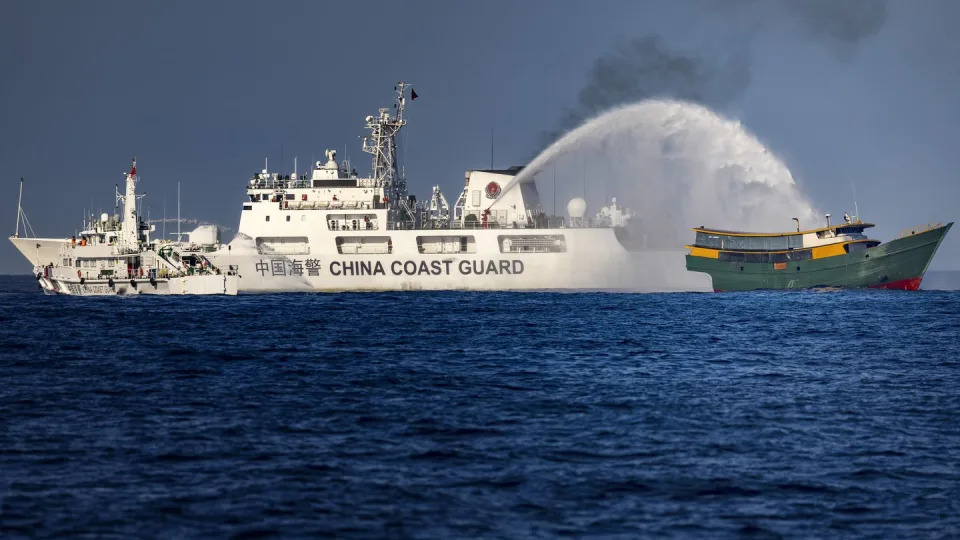
The U.S. and the Philippines have held Balikatan, a Tagalog word for “shoulder to shoulder,” almost annually for nearly 40 years. Yet the scope and size of the exercise has been relatively limited until the last few years. The exercise’s expansion is a direct reflection of the Philippines’ acknowledgment its territorial defenses are lacking.
“Exercises are like a second language that, as you are performing the exercise, you are also sending a message to both your adversaries, your likeminded partners and other stakeholders,” Col. Michael Logico, director of the joint and combined training center of the Philippines Armed Forces and the executive agent of Balikatan, told Defense News.
The exercise used to be confined to central military locations within the main island of Luzon, but now events are spread across the country from the most northern islands all the way to the southwestern island of Palawan.
The expansion of the exercise to places like Ilocos Norte, along the northwestern coast of Luzon island, “sends a message of confidence in our ability to protect as north as possible. It’s also a message of deterrence. So if any of our adversaries have any designs that involve the areas up north, we are saying that we are challenging your maritime and air presence in this area by our presence alone, or by our bilateral presence alone,” Logico said.
The exercise series, which typically focused on humanitarian assistance and disaster relief as well as counterterrorism mission sets, is now centered around complex operations across domains.
While Balikatan was previously a bilateral event, the exercise now includes over a dozen more countries as observers or direct participants, and that number is expected to grow.
AfriPrime App link: Absolutely risk free and FREE for download...
https://www.amazon.com/Africircle-AfriPrime/dp/B0D2M3F2JT
‘Comfortable with the discomfort’
Over the two weeks of Balikatan beginning in April and ending in May, 233 Chinese vessels were spotted in the West Philippine Sea — a term the Philippine government sometimes users in reference to its exclusive economic zone — according to a front-page story in the May 8 edition of The Manila Times.
The Philippines is “getting their teeth kicked in once a month by the Chinese in the Spratly [Islands],” Gregory Poling, an Asian maritime expert with the Center for Strategic and International Studies think tank, told Defense News.
Tension may be greatest in the Second Thomas Shoal, where there is a Philippine marine contingent aboard a World War II-era tank landing ship, the Sierra Madre. The ship has been on the reef since 1999, Poling said.
The Sierra Madre keeps Chinese forces off the strategic spot, but “in the next storm, it could be gone,” according to Mark Montgomery, an Asia-focused analyst with the Foundation for Defense of Democracies think tank.
“If that thing blows off, the Chinese will take over the Second Thomas Shoal. [It will] never have a Philippine footprint again,” he told Defense News.
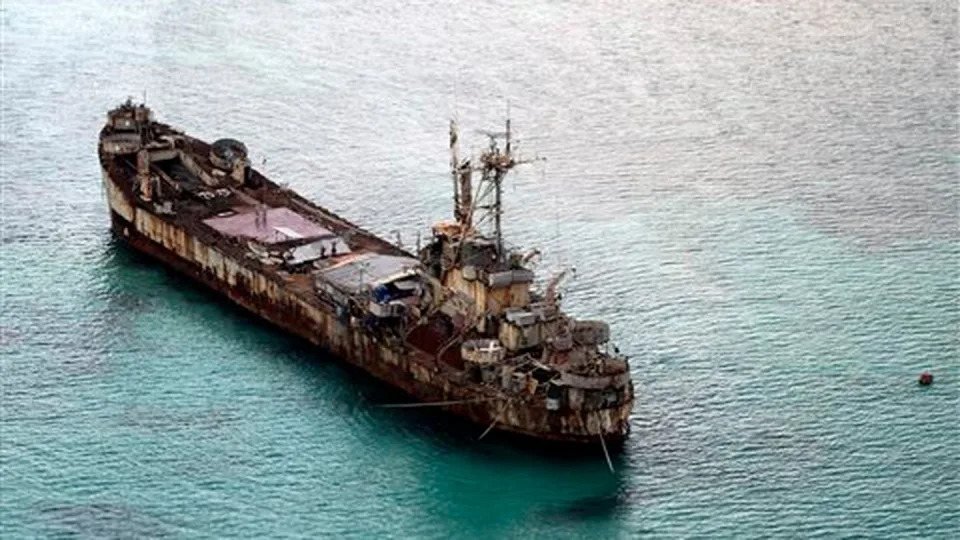
China has been “getting wildly reckless” there in recent months, according to Poling, who said the country regularly sends at least 50 boats around the shoal every time the Philippines resupplies the Sierra Madre, harassing the crew with high-pressure water cannons, acoustic devices and military-grade lasers.
The previous president of the Philippines, Rodrigo Duterte, distanced his government from the U.S. and temporarily canceled a visiting forces agreement between the two nations. According to the Pentagon, the agreement’s activities “range from expert exchanges to ship visits to component exercises and major joint/combined training exercises.”
Duterte had also paused the Balikatan exercise in 2020 in an attempt to improve relations with China. However, the situation in the South China Sea did not improve.
The new president, Bongbong Marcos, has worked to rapidly strengthen relationships with the U.S. and some other countries in the Pacific since his election in 2022.
“The Philippine military is now focused on territorial defense operations, and that shift from counterinsurgency is in support of our allies and in support of our treaty allies. That defense matters,” Gen. Charles Flynn, the head of U.S. Army Pacific, said in May. “We help defend terrain, we help defend people, and ... we help them protect and defend their territorial integrity and national sovereignty.”
During Balikatan in 2023, the Philippine Army wanted to conduct a littoral live-fire drill in the Ilocos Norte province, but instead was instructed to move the event south to Zambales, where there is already a military installation, due to political reasons, Logico said.
“At the start of the planning conference [for 2024], I made it my personal goal to bring the exercise back to Ilocos Norte,” Logico said. Not only does it send a message that the Philippines can project military power, but “it is a way for us to be comfortable with the discomfort of the area.”
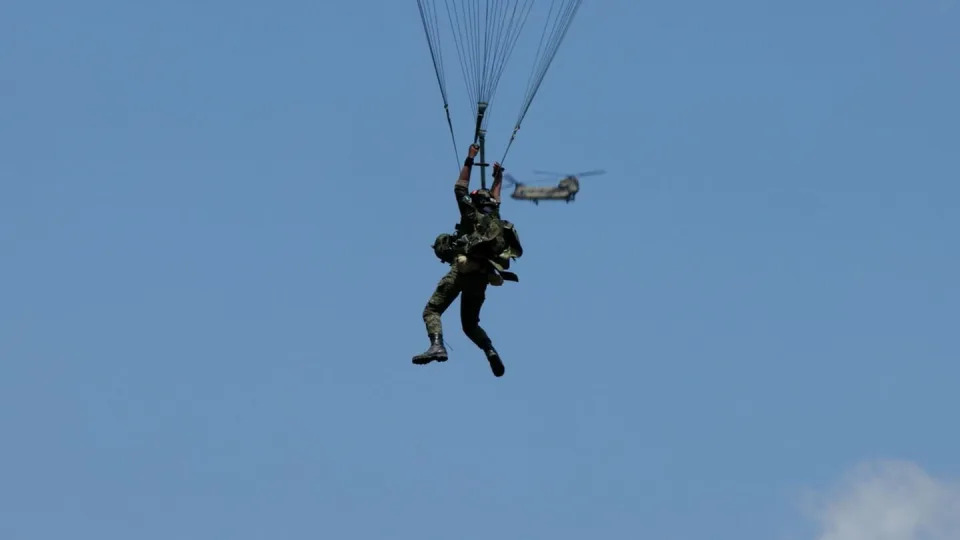
Previous instances of the exercise took place within military camps or naval training facilities, such as Fort Magsaysay located in central Luzon, Logico noted. “Some of them are a little bit restrictive,” he said. “It’s a controlled environment.”
Logico also had two more goals previously prohibited by the Duterte administration: to conduct live-fire drills and other exercises at sea beyond 12 nautical miles of the Philippines; and to train in the West Philippine Sea. (An exclusive economic zone typically extends 200 nautical miles beyond a country’s territorial sea.)
The Philippine military, along with its American and Australian partners, held a large, live-fire exercise that sank a ship off the coast of Ilocos Norte on May 8. And this year, Balikatan extended 300 nautical miles into the West Philippine Sea, Logico said.
American-style deterrence
While the Philippines is focused on its own defense, America is trying to strengthen its Pacific partnerships. It sees the archipelago nation as key to building a network of land forces that can deter those who would threaten regional stability, according to Flynn, the chief of U.S. Army Pacific.
Not only is the Philippines the United States’ oldest ally in the region, but it’s also positioned closely to Taiwan, an island China considers a rogue province and has threatened to take back by force.
Part of the U.S. Army’s strategy in the Pacific, Flynn said, is to build a strategic land power network. That network “must get in position to defend our sovereignty, to protect our people and to uphold their rights under international law,” he said in May at the Association of the U.S. Army’s LANPAC conference in Honolulu, Hawaii.
AfriPrime App link: Absolutely risk free and FREE for download...
https://www.amazon.com/Africircle-AfriPrime/dp/B0D2M3F2JT
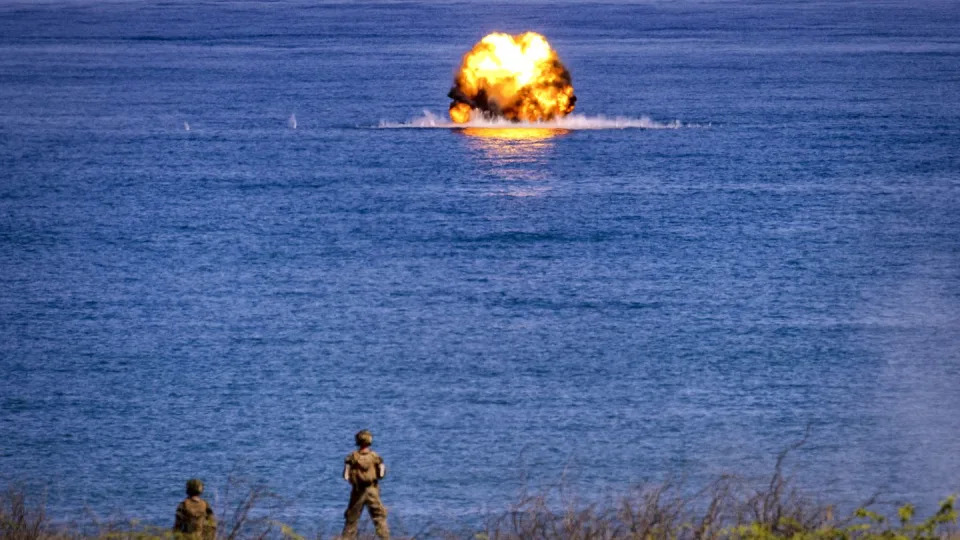
The Army does not have the same type of setup in the Pacific region as it does in Europe when it comes to pre-positioned stock, and there is no NATO member from Asia. As a result, the U.S. aims to establish relationships with individual island nations in the Pacific so it can assume a stronger regional posture.
Balikatan and the Salaknib exercise, which took place in April and May, are part of that. This year saw U.S. military presence push deeper into the Philippines’ northern islands.
For example, the U.S. Army’s 1st Multi-Domain Task Force set up a company command post in Basco, a small island in the northern island chain, to conduct intelligence, surveillance and reconnaissance. On a clear day, Taiwan is visible from points on the remote island.
Also on Basco, Army divers helped dredge a harbor area and construct a new pier capable of accommodating larger ships.
On Itbayat, Basco’s neighbor to the north, the service’s 8th Theater Sustainment Command was building a warehouse to support humanitarian assistance.
The Army also practiced the rapid deployment of its High Mobility Artillery Rocket System throughout the Philippines, from Palawan to La-Lo Airport on northern Luzon to Port Irene further north.
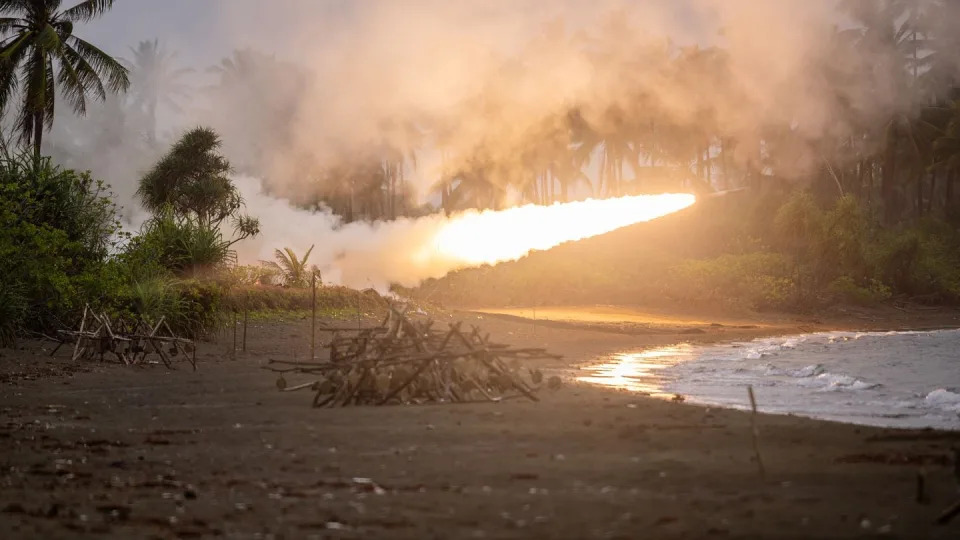
Meanwhile, the multidomain task force for the first time deployed its nascent Mid-Range Capability missile launcher. The weapon traveled to Laoag on the northwest coast of Luzon from Joint Base Lewis-McChord in Washington state.
Three of the four sites under the Enhanced Defense Cooperation Agreement were used in varying forms during Balikatan. The agreement allows the U.S. to fund infrastructure improvement and construction efforts at existing Philippine military bases, among other locations, and to rotationally deploy troops. The deal was signed in 2014 and originally established six sites. In 2023, four more sites were added.
One of the largest undertakings is the U.S. Army’s deployment of an exportable version of its Joint Pacific Multinational Readiness Center. The Army brought the capability to Fort Magsaysay, one of the agreement’s sites, to conduct a training rotation with the Philippine military as the Pacific nation looks to establish its own high-level training capability akin to the center.
Shoulder to shoulder
In preparation for Balikatan, Maj. Gen. Leodevic Guinid, the Philippine Army’s vice commander, said he told participating forces to focus on being able to fight side by side and to consider whether “you think that we are ready, that we are interoperable.”
Indeed, this effort to ensure the nations’ forces can work together seamlessly is fresh, Guinid said, and there is room for improvement on, for example, tactics, data sharing and the distribution of certain capabilities.
But there’s been progress. For instance, during a live-fire drill as part of Salaknib, a U.S. fires team flew an unmanned aerial system that was taking full-motion video of targets on the range, while Filipino soldiers remained in a concealed position, according to Brig. Gen. David Zinn, the deputy commander of the U.S. Army’s 25th Infantry Division.
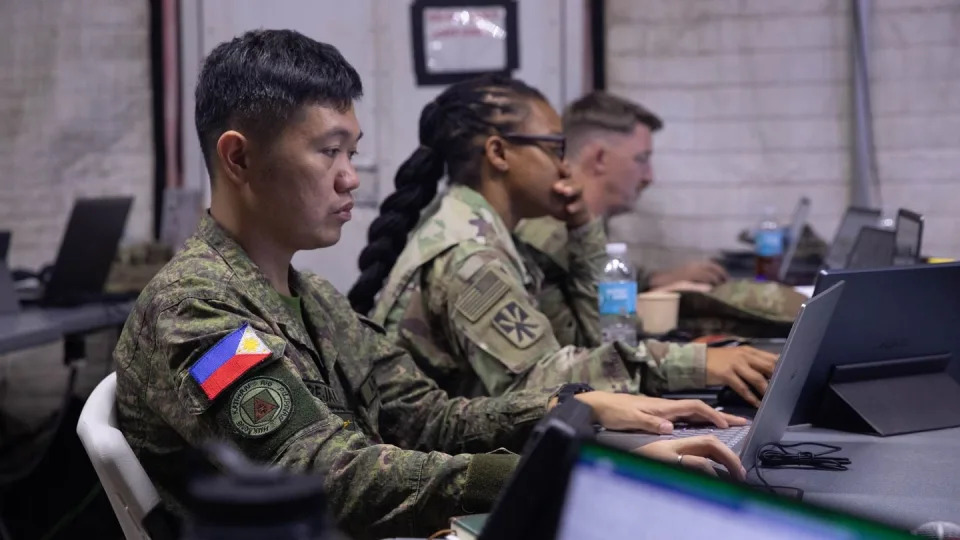
“That video was viewed from the U.S. battalion command post, and the Philippine company commander was at the U.S. command post looking at the video to see that intelligence,” Zinn told Defense News. The Filipino commander then used a U.S. radio to communicate to his fires team using Philippine radios to move forward and destroy targets.
Watching the demonstration looks simple, Zinn said, because it’s a radio call. “But having been part of working to gain technical interoperability with partners in the past, it was pretty significant what they did, and we only achieve that by working together and spending time doing it,” he noted.
Beginning during last year’s Balikatan drills in the northern part of Luzon, the 1st Multi-Domain Task Force helped develop a Combined Information and Effects Fusion Cell that would allow the U.S. and the Philippines to see the same information and coordinate actions, which previous iterations of the exercise lacked.
“One thing that we realized quickly was oftentimes we try to increase classification when we build these command-and-control nodes based off of sharing agreements,” Brig. Gen. Bernard Harrington, who commands the task force, told Defense News in an interview at LANPAC.
“We found that the best thing to do was to drive this down to an unclassified level,” Harrington said. “We have human interoperability by being in the same room together. We had technical interoperability to rebuild this network with the system, and then we have procedural interoperability.”
Harrington said they continued to improve the capability during this year’s Balikatan events and now want to provide it to other regional allies and partners.
Logico said still more can be done to benefit interoperability at future exercises, adding that they ought to focus on information warfare, the cyber domain, and low-tech solutions to high-tech problems.
“If we are slow to the learning curve, we would find ourselves being outmaneuvered, so this is something that we have to pay attention to now,” he said.
AfriPrime App link: Absolutely risk free and FREE for download...



